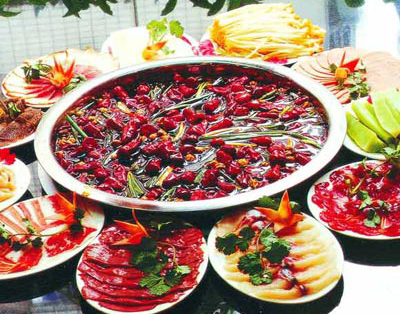
(Chinayak)
By Fang Ye(方也)
Nov 13, 2012
Economic Observer Online
Translated by Laura Lin
Original article: [Chinese]
Just like the American tourist who, when traveling in China or Europe, will look for a McDonald's, most Chinese people who go abroad also like to stick to the food they are familiar with.
Many self-deprecatingly call this the uncontrollable “Chinese stomach.”
After a week traveling abroad, even if the Chinese visitor has his choice of Iranian caviar or French oysters, there’s nothing he would like more than a Chinese stir-fry and a warm bowl of wonton soup. Only then can he really feel alive again.
Some people are convinced that the Chinese love their own cooking so much because Western food doesn’t taste as good. Of course we would never say such a thing to our generous Western hosts.
In comparison to other nationalities, Chinese people have difficulty assimilating, and this is best manifested in their food. Chinese culture has embraced many things. Today there are as many skyscrapers in Shanghai as there are in New York, and Hollywood movies make their biggest box office in China. Nevertheless, the stubborn Chinese stomach is one area that refuses to be westernized.
When Qiao went to study at Columbia University in 1994, apart from various ingredients for Chinese cooking, she also brought an electric kettle and a rice cooker with her.
This isn’t much different from her Chinese predecessors who migrated to the U.S. more than 100 years ago. The first waves of Chinese gold-rush laborers brought their woks and chopping knives.
Naturally, the vast majority of these early Chinese laborers failed to find the gold they dreamed of. But the knives and the wok helped them to gain a firm foothold far away from home.
Chinese restaurants
It’s believed that the first Chinese restaurant outside of China was San Francisco’s “Canton” restaurant, which opened in 1849. By 1920, 25 percent of the Chinese people living in America were working in the Chinese food industry.
To make a little pocket money, Qiao worked in a tiny Hong Kong teahouse in New York. The menu featured dim sum dumplings. The teahouse was run by a couple who had emigrated from Hong Kong. The husband was the chef, the wife the cashier, and Qiao the waitress.
These awkwardly tiny Chinese restaurants in Chinatowns around the world were important for the survival of newcomers – a psychological sanctuary.
Every morning there were always the same regular customers sitting in their usual seats, reading a Chinese newspaper and greeting each other with Cantonese pleasantries. This is also where people left their children when they had an errand to run, where neighbors resolved their disputes or where you would see old people desperate for a touch of home.
With a greater and greater influx of Chinese immigrants coming from different regions of China and speaking mutually unintelligible dialects, the inward-looking overseas-Chinese community scene went extinct.
Today, Chinese restaurants have long left Chinatown for other parts of the city, whether it’s in the small streets behind the skyscrapers of Manhattan or in Uganda.
Fast-food chains
The first Chinese restaurants were opened by immigrants from Canton (called Guangzhou today), in the south. Then came new immigrants from Taizhou, Zhejiang Province in the east. Their cooking skills were not as good as those of the Cantonese, but they were hardworking and their restaurants were open all year round except for Chinese New Year. Their low prices soon drove half of their Cantonese compatriots out of business. After that immigrants from Fuqing of Fujian province in the southeast of China poured in. This new wave of restaurateurs opened Chinese fast-food outlets that rivaled pizza parlors and McDonald's.
This variety of Chinese cuisine contributed to its popularity abroad. Even President Barack Obama was photographed buying take-out from a San Francisco Chinese restaurant!
Unlike earlier times, when the only thing a foreigner could buy in a Chinese restaurant was a darkish-looking dish full of soy sauce and fried butter, in general, the quality of Chinese cuisine abroad has greatly improved.
Mr. Chow, an upscale Chinese restaurant chain, has probably been the most successful abroad. Funnily enough, many Westerners who eat there comment that the restaurant does not offer “typical Chinese food.”
“We are an authentic Chinese restaurant," says Michael Chow, the chain’s founder. "Since I opened my first restaurant in Knightsbridge, London, 40 years ago, I have been trying to guide the taste of Western diners and develop their palate.”
News in English via World Crunch (link)
